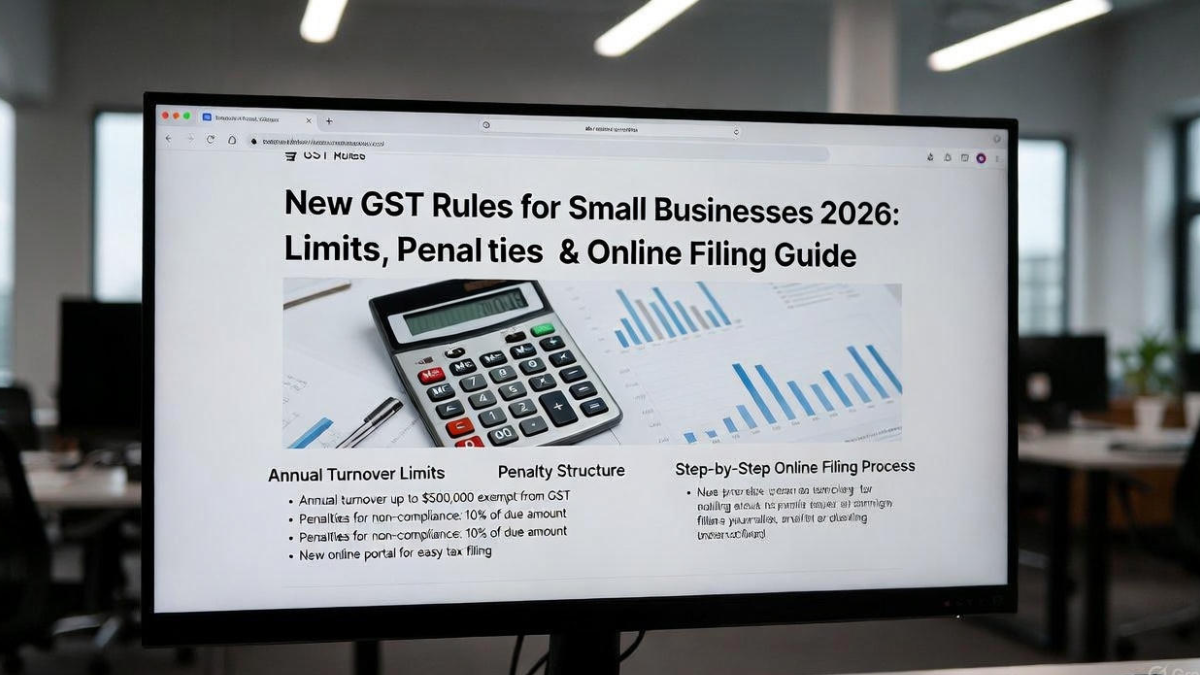The year 2026 has introduced several important changes in GST Rules India, especially for micro, small, and medium-sized enterprises. With thousands of new entrepreneurs entering the market each year, the government aims to simplify compliance and reduce the burden on small businesses. These updates directly impact registration limits, tax rates, e-invoicing requirements, and return filing processes. As a result, understanding the new guidelines has become essential for anyone managing a small enterprise or home-based business.
At the same time, the rise of digital payments, online marketplaces, and automated accounting tools has made tax filing much more accessible. The updated GST Rules India focus on improving transparency and reducing errors in monthly or quarterly filings. For beginners and experienced taxpayers alike, these changes ensure smoother compliance under the Small Business Tax system. With better clarity and reduced penalties, business owners can now focus more on growth and less on paperwork.

Key GST Changes Small Businesses Must Note in 2026
The government has revised multiple rules to simplify operations and make the tax system more entrepreneur-friendly. For many owners, the most impactful changes relate to turnover limits, updated registration categories, and improved filing mechanisms. These adjustments help reduce compliance pressure on micro enterprises while ensuring proper monitoring of larger businesses. These fresh updates within GST Rules India directly shape how companies handle Small Business Tax obligations throughout the year.
Another important update is the wider rollout of real-time data verification through GSTN, preventing duplicate invoices and fake claims. Small businesses dealing with retail, e-commerce, or service sectors must now adopt digital record-keeping to stay compliant. These measures also reduce the chances of incorrect filings and penalties, making the GST Rules India framework more efficient and transparent.
Updated GST Limits and Compliance Requirements 2026
Here is a detailed table summarizing the updated compliance thresholds, filing cycles, and key requirements under GST Rules India for small enterprises. These rules help clarify what turnover category your business falls under and what type of Small Business Tax filing is required.
| Business Category | Annual Turnover | GST Requirement | Filing Cycle |
|---|---|---|---|
| Micro Business | Up to ₹20 Lakhs | GST optional | Quarterly |
| Small Business | ₹20 Lakhs – ₹75 Lakhs | Composition Scheme | Quarterly with yearly summary |
| Medium Business | ₹75 Lakhs – ₹1.5 Crore | Regular GST | Monthly/Quarterly (QRMP) |
| Service Providers | Above ₹20 Lakhs | Mandatory GST | Monthly |
| E-commerce Sellers | No turnover limit | Mandatory GST | Monthly |
These updated thresholds ensure better categorization of businesses, allowing easier compliance under GST Rules India. The revised slab structures also promote growth by providing tax relief to micro enterprises while streamlining the Small Business Tax structure for medium-scale companies.
Penalties Small Businesses Must Avoid in 2026
Penalties remain a major concern for entrepreneurs, especially those new to GST. The 2026 guidelines focus on preventing errors through digital checks rather than applying heavy fines immediately. However, businesses must still stay careful to avoid unnecessary losses. Common penalties under GST Rules India include late filing fines, mismatched invoices, non-registration despite eligibility, and incorrect input tax credit claims. These mistakes can lead to financial setbacks within the Small Business Tax category if not handled properly.
Even small delays can attract penalties ranging from ₹50 to ₹200 per day, depending on the type of return. E-commerce sellers, retailers, and freelancers should maintain proper invoicing and reconcile monthly sales data to avoid mismatches. With digital tools becoming more affordable, automated software is now widely recommended for those managing Small Business Tax duties under the new 2026 rules.
Step-by-Step Online GST Filing Guide for 2026
The online filing process has become more user-friendly, especially for small businesses using the QRMP (Quarterly Return Monthly Payment) system. Here’s a quick guide to simplify your filing under GST Rules India:
- Visit the GST portal and log in with your business credentials
- Choose the appropriate return type based on turnover
- Upload sales (outward) and purchase (inward) invoices
- Reconcile data automatically through GSTN
- Pay tax using available modes (UPI, net banking, debit card)
- Submit the return and download the acknowledgment
These steps allow small enterprises to manage their Small Business Tax responsibilities smoothly and avoid errors. With the 2026 updates, the portal now offers faster processing, fewer technical glitches, and better data tracking to help businesses comply with GST Rules India.
Conclusion
The revised GST Rules India for 2026 mark a major step toward simplifying tax compliance for millions of small businesses. With updated turnover limits, improved filing systems, and clearer penalty structures, businesses can operate with more confidence and convenience. The stronger digital framework ensures that Small Business Tax processes are transparent, efficient, and easier to manage. By staying informed and using digital tools, entrepreneurs can navigate GST requirements smoothly while focusing on business expansion. As India’s entrepreneurial ecosystem grows, these reforms play a crucial role in strengthening compliance and boosting business confidence.
FAQs
What are the updated GST limits for small businesses in 2026?
The new GST Rules India set turnover thresholds of ₹20 lakhs for optional registration and up to ₹75 lakhs for the Composition Scheme under Small Business Tax.
Is GST mandatory for online sellers?
Yes, e-commerce sellers must register for GST regardless of turnover due to updated GST Rules India.
What is the penalty for late GST filing?
Penalties range from ₹50 to ₹200 per day, depending on the return type, affecting compliance under Small Business Tax rules.
Can small businesses file GST returns quarterly?
Yes, businesses under the Composition Scheme or QRMP can file quarterly returns as per revised GST Rules India.
How can small businesses simplify GST compliance?
Using digital invoicing tools and regularly reconciling data helps reduce errors and ensures smoother Small Business Tax filing.
Click here to learn more